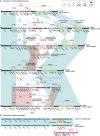Novel Chromosome-Borne Accessory Genetic Elements Carrying Multiple Antibiotic Resistance Genes in Pseudomonas aeruginosa
- PMID: 33816340
- PMCID: PMC8012812
- DOI: 10.3389/fcimb.2021.638087
Novel Chromosome-Borne Accessory Genetic Elements Carrying Multiple Antibiotic Resistance Genes in Pseudomonas aeruginosa
Abstract
Pseudomonas aeruginosa is noted for its intrinsic antibiotic resistance and capacity of acquiring additional resistance genes. In this study, the genomes of nine clinical P. aeruginosa isolates were fully sequenced. An extensive genetic comparison was applied to 18 P. aeruginosa accessory genetic elements (AGEs; 13 of them were sequenced in this study and located within P. aeruginosa chromosomes) that were divided into four groups: five related integrative and conjugative elements (ICEs), four related integrative and mobilizable elements (IMEs), five related unit transposons, and two related IMEs and their two derivatives. At least 45 resistance genes, involved in resistance to 10 different categories of antibiotics and heavy metals, were identified from these 18 AGEs. A total of 10 β-lactamase genes were identified from 10 AGEs sequenced herein, and nine of them were captured within class 1 integrons, which were further integrated into ICEs and IMEs with intercellular mobility, and also unit transposons with intracellular mobility. Through this study, we identified for the first time 20 novel MGEs, including four ICEs Tn6584, Tn6585, Tn6586, and Tn6587; three IMEs Tn6853, Tn6854, and Tn6878; five unit transposons Tn6846, Tn6847, Tn6848, Tn6849, and Tn6883; and eight integrons In1795, In1778, In1820, In1784, In1775, In1774, In1789, and In1799. This was also the first report of two resistance gene variants blaCARB-53 and catB3s, and a novel ST3405 isolate of P. aeruginosa. The data presented here denoted that complex transposition and homologous recombination promoted the assembly and integration of AGEs with mosaic structures into P. aeruginosa chromosomes.
Keywords: Pseudomonas aeruginosa; ST3405; blaCARB-53; catB3s; mobile genetic elements; β-lactam resistance.
Copyright © 2021 Yu, Yang, Li, Chen, Hu, Jing, Luo, Yin, Zou and Zhou.
Conflict of interest statement
The authors declare that the research was conducted in the absence of any commercial or financial relationships that could be construed as a potential conflict of interest.
Figures







Similar articles
-
VIM-encoding IncpSTY plasmids and chromosome-borne integrative and mobilizable elements (IMEs) and integrative and conjugative elements (ICEs) in Pseudomonas.Ann Clin Microbiol Antimicrob. 2022 Mar 9;21(1):10. doi: 10.1186/s12941-022-00502-w. Ann Clin Microbiol Antimicrob. 2022. PMID: 35264204 Free PMC article.
-
Genetic Characteristics of Novel IncpSE5381-aadB Plasmids, Integrative and Mobilizable Elements, and Integrative and Conjugative Elements in Pseudomonas aeruginosa.Infect Drug Resist. 2024 May 25;17:2053-2068. doi: 10.2147/IDR.S462670. eCollection 2024. Infect Drug Resist. 2024. PMID: 38813527 Free PMC article.
-
Chromosomal Integration of Huge and Complex blaNDM-Carrying Genetic Elements in Enterobacteriaceae.Front Cell Infect Microbiol. 2021 Jun 15;11:690799. doi: 10.3389/fcimb.2021.690799. eCollection 2021. Front Cell Infect Microbiol. 2021. PMID: 34211858 Free PMC article.
-
Antibiotic resistance in Pseudomonas aeruginosa - Mechanisms, epidemiology and evolution.Drug Resist Updat. 2019 May;44:100640. doi: 10.1016/j.drup.2019.07.002. Epub 2019 Jul 19. Drug Resist Updat. 2019. PMID: 31492517 Review.
-
Pseudomonas aeruginosa chromosomal beta-lactamase in patients with cystic fibrosis and chronic lung infection. Mechanism of antibiotic resistance and target of the humoral immune response.APMIS Suppl. 2003;(116):1-47. APMIS Suppl. 2003. PMID: 14692154 Review.
Cited by
-
Multiple Copies of Mobile Tigecycline Resistance Efflux Pump Gene Cluster tmexC2D2.2-toprJ2 Identified in Chromosome of Aeromonas spp.Microbiol Spectr. 2022 Dec 21;10(6):e0346822. doi: 10.1128/spectrum.03468-22. Epub 2022 Nov 10. Microbiol Spectr. 2022. PMID: 36354336 Free PMC article.
-
Emergence of Aeromonas veronii strain co-harboring blaKPC-2, mcr-3.17, and tmexC3.2-tmexD3.3-toprJ1b cluster from hospital sewage in China.Front Microbiol. 2023 May 17;14:1115740. doi: 10.3389/fmicb.2023.1115740. eCollection 2023. Front Microbiol. 2023. PMID: 37266015 Free PMC article.
-
Epidemiology and resistance mechanisms of tigecycline- and carbapenem-resistant Enterobacteriaceae in China: a multicentre genome-based study.Front Microbiol. 2025 May 7;16:1582851. doi: 10.3389/fmicb.2025.1582851. eCollection 2025. Front Microbiol. 2025. PMID: 40400686 Free PMC article.
-
Prioritization of Critical Factors for Surveillance of the Dissemination of Antibiotic Resistance in Pseudomonas aeruginosa: A Systematic Review.Int J Mol Sci. 2023 Oct 15;24(20):15209. doi: 10.3390/ijms242015209. Int J Mol Sci. 2023. PMID: 37894890 Free PMC article.
-
First Report of bla OXA-677 with Enhanced Meropenem-Hydrolyzing Ability in Pseudomonas aeruginosa in China.Infect Drug Resist. 2021 Dec 31;14:5725-5733. doi: 10.2147/IDR.S340662. eCollection 2021. Infect Drug Resist. 2021. PMID: 35002263 Free PMC article.
References
Publication types
MeSH terms
Substances
LinkOut - more resources
Full Text Sources
Other Literature Sources
Medical

